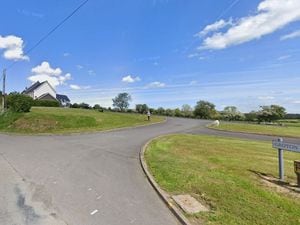Climate protest: Shropshire Council 'confident' in being carbon neutral by 2030
Shropshire Council has reiterated its stance on tackling the climate emergency it declared a year ago - after a protest outside Shirehall by Extinction Rebellion campaigners.

Councillor Dean Carroll said: "It takes time to make sure the right things are done."
He said the council is "confident" it will achieve its goal of becoming carbon neutral by 2030.
Councillor Carroll, the council's cabinet member for adult social care, public health and climate change, added that the authority has taken steps to ensure carbon reduction is a "normal consideration in all operations".
It comes after more than 100 pairs of shoes were placed outside the council's headquarters in Shrewsbury by protestors who claim the authority's response has been "shameful".
The shoes were left on the lawn outside Shirehall by Extinction Rebellion activists, with each pair of shoes meant to represent a Shropshire resident who wanted to be there to protest but couldn’t because of the lockdown.
Read more:
Councillor Carroll said: “Shropshire Council was already working to reduce its carbon footprint and direct impact on the climate prior to the declaration of a climate emergency in May 2019. For example, since 2012, our direct emissions have reduced by 26 per cent."
Following the climate emergency declaration in May 2019, the council formed its Climate Change Task Force in efforts to aid an existing working group of officers from the authority.
Councillor Carroll added: "To drive improvements corporately we have taken steps to make carbon reduction a normal consideration in all operations. Climate action appraisals are now compulsory in all key council decisions, forcing climate impact to be considered and criteria to be met.
"We are working across council services to develop and implement design guidance for new council buildings, and to improve the performance of existing ones. We have also provided key staff with carbon literacy training to equip them with the knowledge and skills they need to reduce carbon emissions across the council."
Workshop
Councillor Carroll also moved to highlight a climate action workshop held earlier this year which involved more than 100 stakeholders from business, agricultural and community groups.
He said: “These were extremely positive, and feedback and suggestions given to us are playing a pivotal role in shaping our future plans and the development of a wider climate action strategy. We are also working jointly with Telford & Wrekin Council on the development of a climate action partnership to help provide community leadership and help stakeholders across Shropshire to tackle the challenge of climate change."
In 2019, government data showed that Shropshire was ranked fifth nationally for installed renewable energy capacity.
"Since the first installation in 2012, solar PV installed on Shropshire Council assets has generated enough to power 2,000 homes for a year," Councillor Carroll said.
"A GIS mapping feature has now been added to highlight technical details and how much financially each individual site is expected to save which you can view on our website.
“Since September 2019, all of the electricity consumed by Shropshire Council has been supplied purely from renewable sources. Sites are being assessed in both land and buildings with potential for renewable energy across Shropshire Council’s estate.
"Through grant funding, solar PV has been installed at Greenacres Farm and Shrewsbury Market Hall and we have installed energy efficiency measures including LED lighting at Theatre Severn, Shropshire Archives and Bridgnorth Library as well as an air-source-heat-pump at Severn Valley Country Park. You can view the individual cases online."
Since 2013, the council has converted more than 3,300 street lights to LED lighting and said over the next three years, it will be investing around £6.83 million to convert the remaining 16,253 street lights, reducing energy consumption by 56 per cent and saving 794.5 tonnes of CO2 emissions per year.
Benefits
Councillor Carroll said: “We also recognise that there is a crisis in the natural world, and we are looking at opportunities to both reduce climate impacts and enhance wildlife at the same time. For example, by planting trees and restoring carbon storing soils and wetlands.
“Despite the Covid-19 situation our WARP-it (waste action re-use programme) membership has grown to 237 staff, with over 17 tonnes CO2e saved – which is the equivalent of planting 17 trees – nearly 8 tonnes waste has been avoided, and we are still on target for £50k financial savings by the end of this year."
Councillor Carroll also said that the environmental benefits caused by lockdown restrictions are being studied.
“Given the undoubted climate benefits we have seen globally during the lockdown caused by Covid-19, we are carefully examining opportunities to permanently sustain higher levels of home working," he said.
"We have also updated and refreshed our cycle to work scheme to help reduce the carbon footprint of our office accommodation and staff journeys to work."
The council has also been working on reducing the carbon impact of public transport, including implementing electric buses.
Councillor Carroll said: “We have drawn up several expressions of interest for funding from the Department of Transport and were recently successful in our initial bid for funding to improve part of the current public transport offer. We are also hoping to electrify the Shrewsbury bus fleet and to improve rural transport solutions to reduce the need for longer journeys.
"In addition to this, we are currently drafting a new Park & Ride Strategy for Shrewsbury which will prove a ‘next generation transport system’ and compliment active travel within the town. As well as all of these initiatives, we are also exploring opportunities to electrify our own vehicle fleet and provide greater opportunities for staff to access climate-friendly vehicles for work and personal use.
“We are developing a corporate climate change strategy and an annual action plan which will set out the key areas where the council will focus its efforts and specific projects which will move us closer to our goal of net-zero performance.
“It takes time to make sure the rights things are done that will have the optimal and most sustainable impact. We are working hard to become a carbon neutral council by 2030 and are confident we will achieve this goal.”





